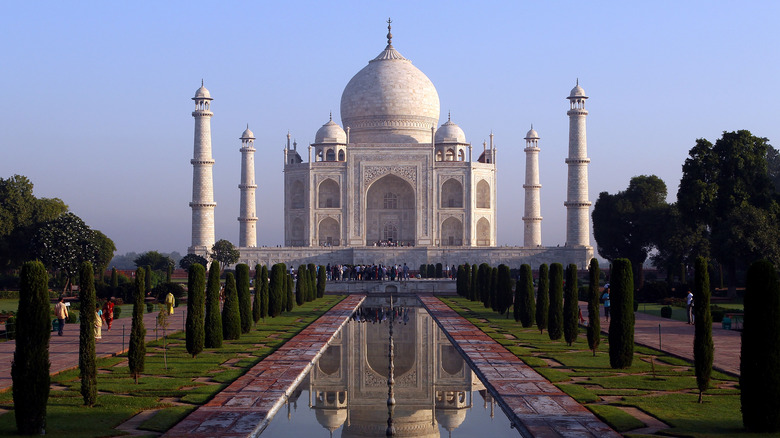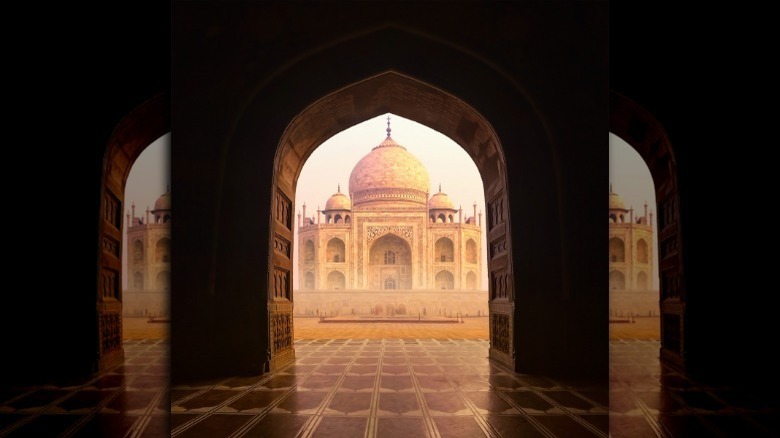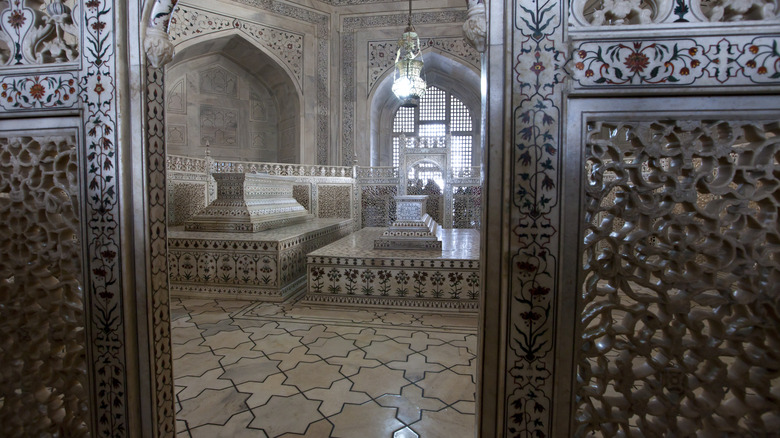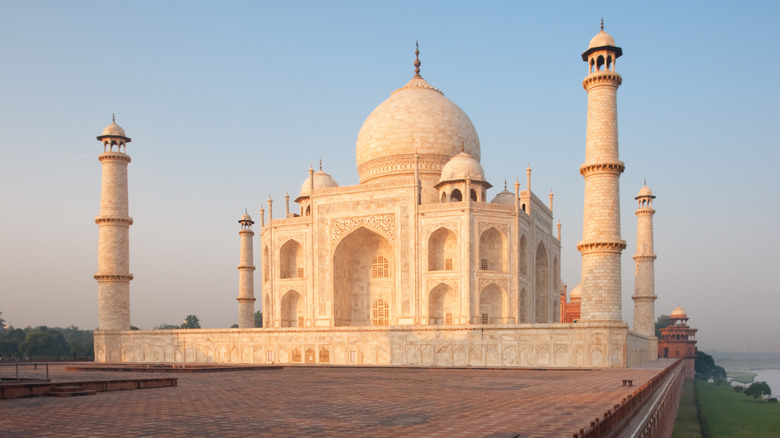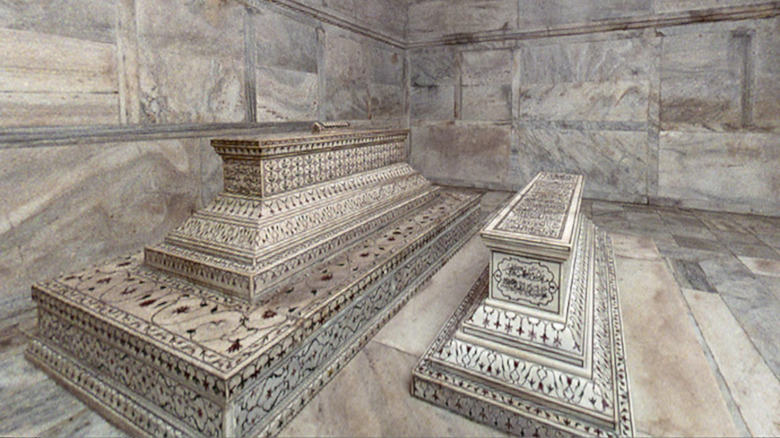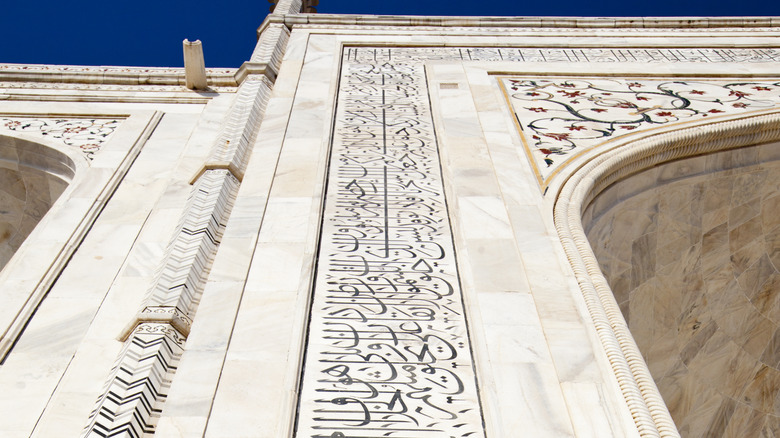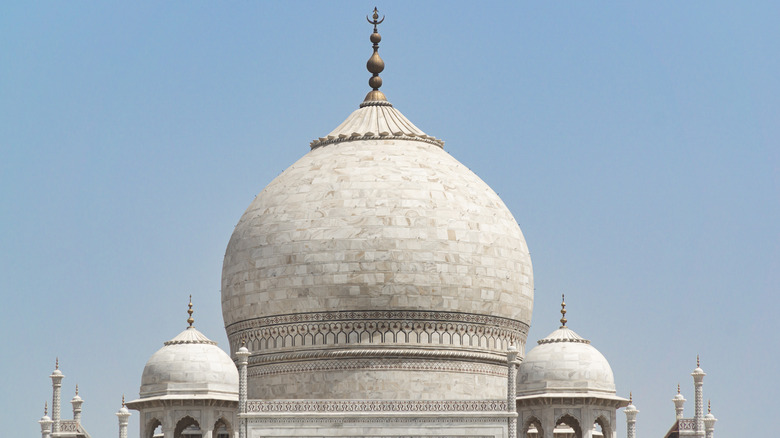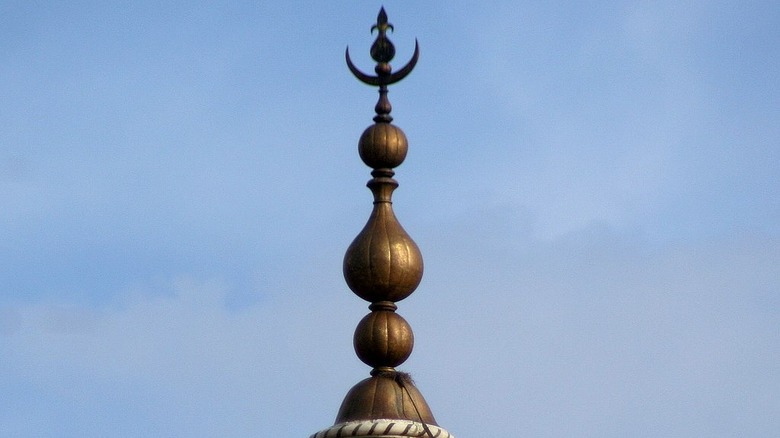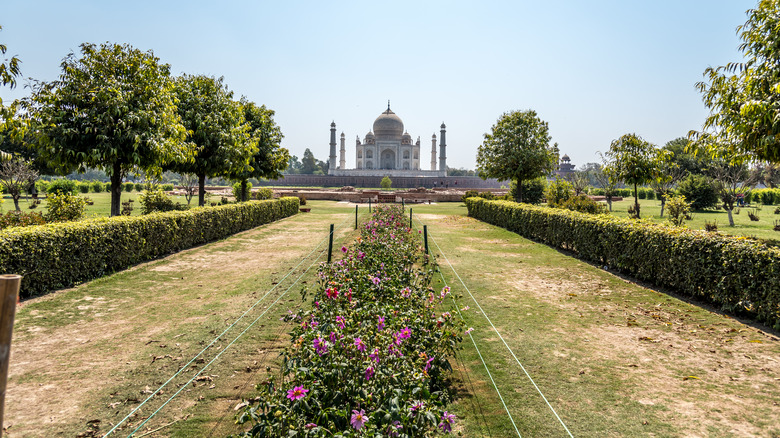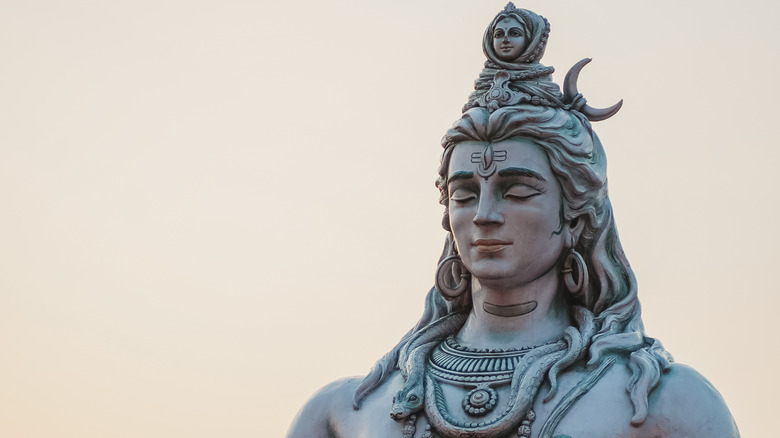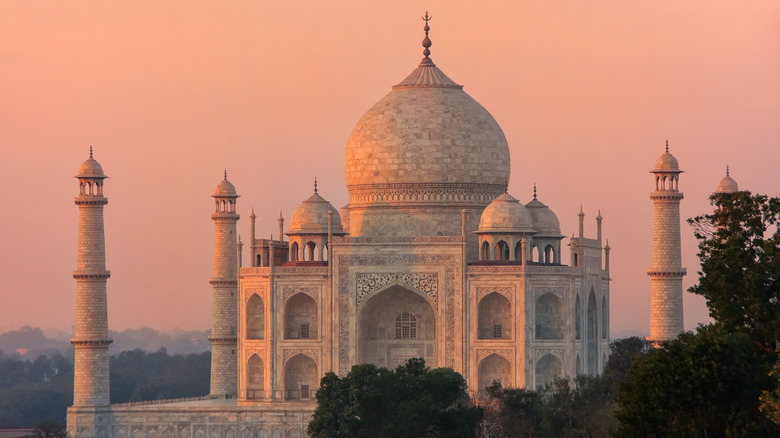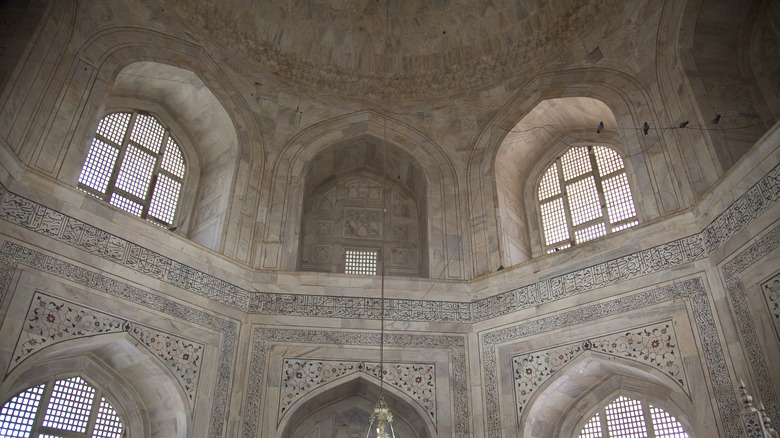Hidden Secrets Of The Taj Mahal
The Taj Mahal in Agra, India is one of the most famous and best-loved landmarks in the world. Most people know the basic story behind it — a powerful Mughal emperor, Shah Jahan, commissioned its construction to serve as a spectacular mausoleum for his favorite wife, Mumtaz Mahal. As such, it has been regarded as a symbol of love and devotion for centuries.
It's also one of the most iconic and recognizable examples of Mughal architecture, and is one of the new seven wonders of the world. The beautiful mausoleum is surrounded by lavish, airy gardens and is infused with symbolism representing both spiritual and earthly power. It attracts millions of visitors every year.
However, it also suffers greatly from the depredations of the modern world, as pollution attacks its white marble and the iron joints holding it in place. These problems persist even though car traffic is forbidden near the site in an effort to reduce the air pollution, and the structure is regularly cleaned to keep its marble shining white.
Something this complex, ambitious, and soaked in symbolism inevitably has secrets. As millions of tourists discover every year, despite its fame and familiarity, the Taj Mahal still has surprises for us. Here are the hidden secrets of the Taj Mahal.
The Taj Mahal is an enormous optical illusion
The Taj Mahal was explicitly designed to be all about the visuals. It's meant to be not just a symbol of Shah Jahan's love for his wife, but also a symbol of his power and the supremacy of the Mughal empire. As such, it's one of the most successful building projects in the world. Nearly four centuries after its construction, the Taj Mahal is recognized worldwide for its beauty and visual impact.
But even people who have visited this iconic structure often miss some of the most brilliant aspects of its design — like the fact that the entire structure is designed to fool the eye. Smithsonian Magazine reports that this begins with your first approach to the tomb. When you first enter the main gateway at the complex, the Taj Mahal appears framed in the gate, and appears to be enormous. But as you move closer, the structure seems to shrink, the exact opposite of what your mind expects.
Another illusion involves the minarets, the four towers at each corner of the tomb. Times of India explains that these appear to be perfectly straight, but are in fact angled outward. Ironically, this serves to make the monument appear balanced. It's also designed to protect the tomb itself in the event of a natural disaster — if the minarets collapse, their slight outward lean will send the rubble away from the main building.
The Taj Mahal's apparent symmetry is imperfect
Even a casual glance at a single photograph of the Taj Mahal makes it clear that this monument is all about symmetry. The central dome is surrounded by four smaller domes, then four minarets, and at each end of the main complex, red sandstone buildings mirror each other. Mirroring is incorporated into the overall layout of the entire complex — even the water features on the grounds are designed to reflect the tomb, doubling everything perfectly.
But there's one obvious and jarring exception to this rule of symmetry. Smithsonian Magazine explains that when you enter the Taj Mahal and come to the room where Shah Jahan and Mumtaz Mahal's cenotaphs (the empty sarcophagi symbolizing their earthly remains — their actual tombs are on the lower level) you find that while Mumtaz Mahal's is perfectly centered in the room, Shah Jahan's is off-center, next to that of his wife. Considering how much effort went into the harmony and balance of the monument, this one exception is impossible to ignore.
Times of India reports that this discordant feature has led many to speculate that Shah Jahan never intended to have his own remains placed in the Taj Mahal. Some believe he intended to build a "black Taj Mahal" as a mirror-image across from the existing monument, but was deposed and imprisoned by his son before he could carry out his wishes.
The Taj Mahal's foundations are made of wood
The Taj Mahal is famous not only because of the symmetry of its design and the beauty of the finished product, but also because of its scale. It is an enormous structure that manages to convey lightness and weight simultaneously. Add in the fact that this huge monument was designed and built in order to commemorate a single person and you have a recipe for an iconic work of architecture.
But that size comes at a cost: weight. When planning something as huge as the Taj Mahal, you have to start with calculating the load that the foundations will bear. The Constructor explains that the load of the Taj Mahal is huge — the main dome weighs 12,000 tons by itself — so the foundations were carefully constructed to be deep and strong, made out of stone, masonry, and timber.
That's right — a big part of the foundations holding up the Taj Mahal are made from wood that was initially laid down nearly 400 years ago. IndianFolk explains that the wooden foundations have survived this long is because the monument is built on the banks of the Yamuna River — because the wood is always immersed in water, it never has a chance to dry out, rot, or split. But, as reported by BBC News, the water table around the Taj Mahal has been declining for decades, and the foundation may be in serious jeopardy.
Shah Jahan and Mumtaz Mahal's tombs are very plain
The Taj Mahal is lavish. Featuring white marble, originally inlaid with precious stones, and sumptuously decorated, the building is a marvel of beauty and artistic ambition. The gardens surrounding it are equally extravagant and visually striking. There's a reason, in other words, that millions of people make the trip to Agra every year to experience the mausoleum in person.
Many visitors may be unaware that the coffin-like objects on the main level, beautifully decorated with ornate stonework, are not the actual tombs of Shah Jahal and Mumtaz Mahal. They're empty monuments known as cenotaphs, representing the mortal remains. The actual tombs are on a lower level, and are decorated in a much more subdued manner.
HowStuffWorks explains that Muslim tradition frowns upon extravagant grave markers. In fact, as noted by author Ebba Koch in "The Complete Taj Mahal and the Riverfront Gardens of Agra," large tombs also contradict orthodox Hindu teachings, making an extravagance like the Taj Mahal doubly problematic in India. In Muslim tradition, simple, understated stones or markers are fine, but huge markers decorated with gems are not, and decorating a tomb after the burial with flowers or other offerings is discouraged. Having two separate sets of cenotaphs allows for the elaborate decoration of the upper level and the more sedate and respectful actual gravesites below.
The calligrapher of the Taj Mahal signed his work
The Taj Mahal is extravagantly decorated. There are repeated floral patterns, geometric designs, and a wide variety of delicate stone- and tilework throughout the complex. One of the most impressive elements of the decoration is the extensive calligraphy on display.
Wonders of the World explains that the calligraphy was designed by Amanat Khan and is primarily quotations from the Koran. For example, the inscription over the main gate as you approach the tomb reads "O soul, you are at rest. Return to the Lord in peace with him, and he at peace with you."
PBS explains what makes the calligraphy is so incredible: at first glance it might look like it's been painted on by hand, but it's actually a technique of inlaid stone. Amanat Khan designed the lettering and then oversaw artisans who cut the black marble pieces and fitted them perfectly to create the effect. Calligraphy like this was considered incredibly important at the time, because it was seen as transcribing the word of God.
That might explain why Amanat Khan took the very unusual step of signing his work. The phrase "Written by the insignificant being, Amanat Khan Shirazi" appears several times below the inscriptions.
The Taj Mahal's huge central dome is imperfect
The Taj Mahal is celebrated for its symmetry, and one thing that people experience when approaching the structure for the first time is a sense of perfection —everything is spaced perfectly, balanced perfectly, arranged perfectly.
But, as explained by Open The Magazine, there is an almost invisible imperfection in the Taj Mahal. The main dome — sometimes called the Onion Dome due to its shape — isn't symmetrical. In fact, at its widest point it's actually about 5.5% off from perfect symmetry. When an academic named Dilip Ahuja first noticed the asymmetry in the 1980s, he found that no one wanted to believe him, so he proved it in a way that anyone can replicate: He took a photo of the dome, cut out the shape of the dome, and folded it in half. The two halves didn't align.
Seeking to prove it once and for all, Ahuja enlisted the assistance of a fellow professor named M.B. Rajani, who specialized in analyzing satellite imagery. Together they published a 2016 paper proving that the dome is imperfect. There are many theories as to why the imperfection was allowed, ranging from the Islamic practice of introducing deliberate errors to honor God to the simple explanation that the builders messed up.
The Taj Mahal's spire isn't original
One of the most exhilarating aspects of the Taj Mahal's design is the way it seems to effortlessly reach up to the skies. With soaring minarets and pointed domes, the mausoleum seems lighter than several tons of stone could possibly be. This effect is amplified by the way the domes taper to points at the top and are then capped with finials — thin ornamental spires.
The most notable and obvious finial sits atop the main dome, glinting in the sun as you approached the tomb. But most people are unaware that this isn't the original finial. In his book "Taj Mahal," author Giles Tillotson reports that the original finial was made of solid gold and stood 11 yards (33 feet) high. But the official Taj Mahal website notes that the finial was replaced with a bronze replica in the early 19th century. It doesn't detail why the finial was replaced, though, as noted by Afar Magazine, the Taj Mahal was a frequent target of plunder and theft over the years, and the British even schemed at one point to tear down the whole monument and sell the marble for profit. The gold finial may have simply been stolen.
The grounds of the Taj Mahal extend beyond the Yamuna River
Most visitors to the Taj Mahal stay within the immediate grounds. And they can't be blamed — the gardens around the tomb and the structure itself are incredible, and you can easily spend all of your time soaking in their beauty. But the original plans of the complex most likely included the Mehtab Bagh (Moonlight Garden) on the other side of the Yamuna River.
The Chicago Tribune explains that although the Moonlight Garden was known to historians, all signs of its existence had virtually vanished by the 20th century. The Culture Trip reports that the garden predates the Taj Mahal, but that emperor Shah Jahan identified the Moonlight Garden as the ideal place to view the grand mausoleum he was building. It remains the ideal spot to take a photo. In 1994, archaeologists theorized, based on the layout, that the Moonlight Garden had originally been considered part of the overall Taj Mahal grounds.
According to Archaeology, in 2014 further exploration of the Moonlight Garden revealed the remnants of a summer palace built in perfect alignment with the Taj Mahal, strengthening evidence that the Mehtab Bagh should be regarded as part of the Taj Mahal grounds.
The British totally transformed the gardens of the Taj Mahal
If you were able to travel through time and visit the Taj Mahal a few hundred years ago, you would be greeted with a much different scene. As explained by landscape architect Lohita Gupta, the gardens originally designed and cultivated around the tomb were done in Islamic style. The land was divided into quadrants and designed to represent paradise on Earth, with a lot of water features and trees.
After the death of the Taj Mahal's creator, Shah Jahan, the gardens were left largely untended for nearly two centuries, according to Gupta. When the British Raj came to dominate India in the 19th century, the Chicago Tribune reports that the colonizers' first plan for the Taj Mahal was to break it up and sell the valuable stone. The plan supposedly only fell through because the British couldn't find a buyer. Then, Smithsonian Magazine notes, the British destroyed many of the gardens and other structures around the Taj Mahal in order to have a clear line of sight for their military forces.
Finally, George Nathaniel Curzon, 1st Marquess Curzon of Kedleston — usually referred to simply as Lord Curzon — was named Viceroy of India in 1895. He made restoring the Taj Mahal and its grounds a priority, but he did so using British ideas for gardens. The trees were removed, and groomed lawns were installed. The end result is similar to formal gardens found in the U.K and elsewhere in the British empire.
There's a conspiracy theory about the Taj Mahal
For most people, the history and provenance of the Taj Mahal is clear. Mughal emperor Shah Jahan commissioned it to be the burial place of his beloved wife, Mumtaz Mahal, and as a symbol of his power. It's near-perfect symmetry and legendary beauty is a testament to love and devotion.
Not everyone believes that, however. In fact, there is a conspiracy theory that the Taj Mahal was actually built many centuries earlier than is commonly believed, that the Indian government is covering up the truth, and that there are secret, sealed lower levels that no one is allowed into that would reveal the truth.
BBC News reports the theory has its roots in a book written by right-wing historian Purushottam Nagesh Oak. Oak claimed the structure had been built by Hindu rulers as a temple called the Tejo Mahal. Shah Jahan then seized the temple after a battle, renaming it. The Diplomat reports that Oak wrote many books claiming that famous Muslim-built monuments and buildings were actually built by Hindus, expressing an ongoing friction between the Hindu and Muslim populations.
The Taj Mahal changes color
The design and construction of the Taj Mahal in the 17th century was a triumph of Mughal architecture and artistry. Every inch of the tomb features gorgeous detail work, from the beautiful inlaid calligraphy to the proportions of the towers and domes incorporated into the mausoleum. The careful planning results in a long list of amazing effects, from optical illusions to a precisely-timed echo effect.
But one of the most striking effects takes all day and some patient observation to truly appreciate. Smithsonian Magazine explains that the tomb changes color throughout the day. As the sun rises, it will appear pale pink. When the sun is high in the sky, the marble shines bright white. It turns orange as the sun sets, and appears to be blue in the moonlit evenings. In fact, Colorjinn demonstrates this startling effect simply by displaying some random tourist photos taken from roughly the same spot.
Unfortunately, the Taj Mahal is also changing colors literally. BBC News notes that the white marble, assaulted by pollution and insect waste, has turned a shade of yellow and is slowly turning brown and green, despite efforts over the years to reduce nearby traffic and clean the stone.
The Taj Mahal has a very precise echo
Every interior space has what's known as a reverberation time. In a nutshell, an interior space's reverberation time is the length of time it takes for echoes to become inaudible. You can design a room to either prolong or shorten the reverberation time.
Visitors to the Taj Mahal can experience the unique way sound echoes inside the main dome of the tomb. It shouldn't come as a shock that a structure as carefully and meticulously planned as the Taj Mahal has a very specific reverberation time. Reader's Digest reports that it is exactly 28 seconds. According to Realm of History, the echo was incorporated into the design so that prayers offered up to the tomb's occupant, Mumtaz Mahal, would multiply and linger in the air.
Modern-day musicians have sought out the Taj Mahal's main dome for its precise reverberation time. As explained in "The Relentless Pursuit of Tone," from the 1960s to 1990s, jazz flutist Paul Horn released several albums recorded inside ancient spaces, including the Taj Mahal. New Age Music Guide reports that Horn had to smuggle a tape recorder into the monument, where he used the echo to tremendous effect.
